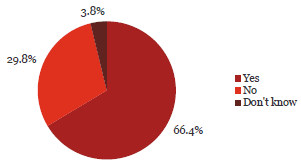42. Budgetary constraints mean that my team has to achieve higher targets with fewer resources.
Observation:

66.4% of respondents indicate that they have to “achieve more with less”.
This was felt more by senior (71%) and line managers (74%) than other roles and felt highest in Government Departments (81%) and District Health Boards (87%).
Organisations that answered “Yes” to this question reported greater occurrences of fraud (24% compared with 20%).
What some respondents have said:
“Tightening of funding for external organisations means that there is greater risk of misreporting of performance by them. The problem is our ability to gather sufficient evidence to determine that it was done with deliberate intent.”
“Money is tighter and organisations do look at structure costs.”
“The nature of tightened circumstances and the change taking place provides opportunities for individuals to abuse trust and commit fraud.”
“While our organisation has not been under significant financial pressure, inevitably some people’s home situation may have become tighter in tighter times, which increases the likelihood of someone taking up an opportunity they may have previously felt not worth the risk.”
“Resource constraints are always there - I do not think they change the culture of the Office if people think they are still being treated fairly .”
| Yes | No | Don’t know | Total Count | ||||
|---|---|---|---|---|---|---|---|
| Chief Executive Officer/Managing Director/Principal | 254 | 67% | 119 | 31% | 7 | 2% | 380 |
| Member of the senior executive/leadership team or equivalent | 346 | 71% | 137 | 28% | 4 | 1% | 487 |
| Line manager (if not one of the above) | 163 | 74% | 48 | 22% | 8 | 4% | 219 |
| Administration/Support Services | 96 | 48% | 76 | 38% | 27 | 14% | 199 |
| Operational staff (e.g. Teacher, Analyst, Advisor, Technician, Officer, Engineer, Accountant) | 84 | 62% | 43 | 32% | 8 | 6% | 135 |
| Total | 943 | 66% | 423 | 30% | 54 | 4% | 1,420 |
| Yes | No | Don’t know | Total | ||||
|---|---|---|---|---|---|---|---|
| Central Government | |||||||
| Autonomous Crown Entities | 35 | 65% | 19 | 35% | 0 | 0% | 54 |
| Central Government - Other | 23 | 51% | 20 | 44% | 2 | 4% | 45 |
| Crown Agents or Companies | 70 | 80% | 16 | 18% | 1 | 1% | 87 |
| Crown Research Institutes | 25 | 68% | 10 | 27% | 2 | 5% | 37 |
| District Health Boards | 61 | 87% | 6 | 9% | 3 | 4% | 70 |
| Government Departments | 118 | 81% | 24 | 17% | 3 | 2% | 145 |
| Independent Crown Entities | 23 | 64% | 11 | 31% | 2 | 6% | 36 |
| Māori Trust Boards | 6 | 55% | 5 | 45% | 0 | 0% | 11 |
| Rural Education Activities Programmes | 7 | 64% | 3 | 27% | 1 | 9% | 11 |
| State-Owned Enterprises | 28 | 60% | 18 | 38% | 1 | 2% | 47 |
| Tertiary Education Institutions | 69 | 77% | 18 | 20% | 3 | 3% | 90 |
| Sub-Total | 465 | 73% | 150 | 24% | 18 | 3% | 633 |
| Yes | No | Don’t know | Total | ||||
|---|---|---|---|---|---|---|---|
| Local Government | |||||||
| Airports | 14 | 78% | 3 | 17% | 1 | 6% | 18 |
| Council Controlled Organisations or Council Controlled Trading Organisations | 42 | 56% | 30 | 40% | 3 | 4% | 75 |
| Energy Companies | 11 | 39% | 16 | 57% | 1 | 4% | 28 |
| Fish and Game Councils | 5 | 63% | 3 | 38% | 0 | 0% | 8 |
| Licensing and Community Trusts | 3 | 33% | 6 | 67% | 0 | 0% | 9 |
| Local Authorities | 115 | 68% | 48 | 29% | 5 | 3% | 168 |
| Local Government - Other | 3 | 27% | 8 | 73% | 0 | 0% | 11 |
| Port Companies | 1 | 50% | 1 | 50% | 0 | 0% | 2 |
| Sub-Total | 194 | 61% | 115 | 36% | 10 | 3% | 319 |
| Schools | 284 | 61% | 158 | 34% | 26 | 6% | 468 |
| Total | 943 | 66% | 423 | 30% | 54 | 4% | 1,420 |

